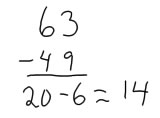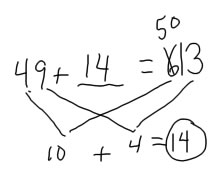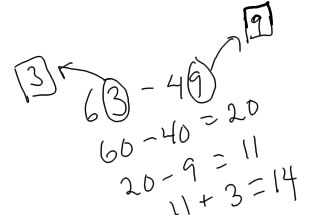


Practice questions answers:
1. What things make a strategy for adding or subtracting 2-digit numbers an efficient strategy?
The most important one is it must join or separate numbers as tens and ones, rather than counting by ones. Also, it is helpful to have good ways to record the strategy.
2. What are some things a teacher can do to encourage solving problems using place value ideas?
The teacher can give problems about objects that are grouped in tens, and the teacher can provide and encourage the use of base 10 manipulatives.
3. What sorts of 2-digit subtraction problems should children learn how to solve first?
Problems without regrouping like 58-43.
4. What would be good numbers to use when beginning subtraction with regrouping problems?
Problems where you are subtracting a 1-digit number from a number that is a multiple of ten, for example, 50-8.
5. Give an example of a subtraction strategy that does not use place value.
Counting back by 1's or direct modeling by representing numbers with counters (or drawings) that represent single objects without groups of 10.
6. Give two examples of subtraction strategies that use place value.
Breaking apart the subtrahend, and subtracting tens and ones from the minuend (in either order--either tens first or ones first).
Breaking apart the minuend and the subtrahend into tens and ones, and subtracting the tens, followed by subtracting the ones of the subtrahend, and adding on the ones from the minuend.
Subtracting tens and ones, using negative numbers to represent differences where the subtrahend is larger than the minuend.
Trading a ten for ten ones and then subtracting tens from tens and ones from ones.
7. Show you understand the strategies. Solve the problem 63-49 using each of these strategies:
| a. |  |
| b. |  |
| c. |  |
8. What is an advantage, as a teaching strategy, of having children come up with their own strategies for addition and subtraction, guided only by good questions from the teacher?
Children understand the strategies they create
Children gain confidence in their ability to make sense of problems
9. What is an advantage of knowing the standard algorithm?
It's an efficient algorithm, it's compact (doesn't take lots of space), and it fits well into other math work children may learn later.